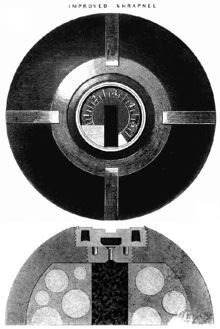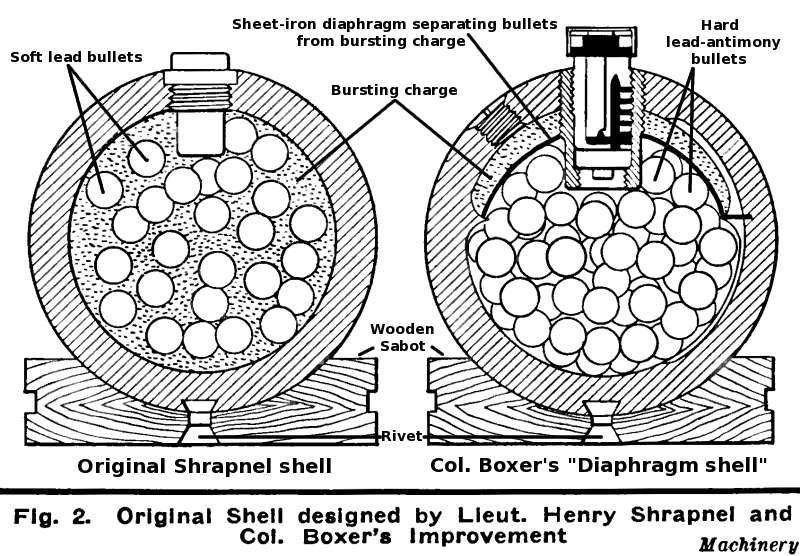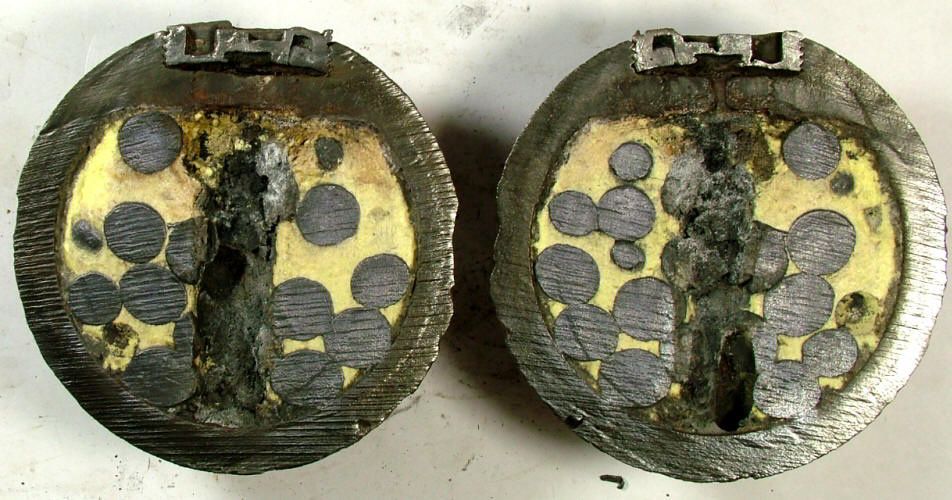
 |
|
|
#1 |
|
(deceased)
Join Date: Dec 2004
Location: Portugal
Posts: 9,694
|
This would be a grenade for a 5 1/2" howitzer, those equiping the defence redoubts of the Lisbon protection against the third Napoleonic invasion (1810-11).
I assume this is a rational conclusion, as this bomb came with no ID evidence, but the its caliber and geographic source largely appoints to such direction. There were 5 1/2" howitzers in all countless redoubts and fortifications of this war episode. Judging by its irregular exterior, it looks more like forged than cast, which i admit to be a nonsense inferrement. Another surprising (for me) particular is that, its fuse orifice is rather narrow, comparing to the others i have seen, which look like measuring at least the double. Noteworthy is that its hollow space is not completely empty; probing it with a stick i find that half ot its space has some kind of contents. Its colour looks too light to be explosive, i would say. I have poured out a tiny bit and set fire to it; it hasn't actualy gone aflame, but it didn't remain completely inert, forming a darker and thiker dust, hence giving me an ilusion that it isn't plain earth. It might as well be a mix of both, dust having penetrated through the hole and convering whatever contents is inside. But my question is more focused on the hole width; does any of the members know how fuse devices functioned those days ? Are they (only) a wood plug containing a (regulable) match cord in a narrow hole ? Why the significant difference in the different grenade hole widths ? Different fuse systems ... narrow ones earlier, large ones later? Your comments and possible referring illustrations will be appreciated. . |
|
|

|
|
|
#2 |
|
(deceased)
Join Date: Dec 2004
Location: Portugal
Posts: 9,694
|
C'mon Gentlemen,
Fire at will 
|
|
|

|
|
|
#3 |
|
Member
Join Date: Mar 2006
Location: Room 101, Glos. UK
Posts: 4,262
|
the lines of torres vedras
 what context was it found in? spherical shells were transported with the fuse hole plugged with tow, and the fuze was added just before firing. the shells themselves might also be shipped in a padding of tow (fibrous material, hemp, cotton, etc.) or with a wooden plug. if the example was buried and it was wet enough to corrode the exterior that badly, the black powder filler (bursting charge) would have the active ingredients dissolved out by the ground water, and tow or plug could have filled the interior to some extent, and decomposed. howitzer shells generally had the area where the fuse was inserted re-enforced to withstand being fired. fuse holes were tapered to fit the factory made tapered beech fuse plug generally used, which would have had a factory cut & timed paper gunpowder fuse inserted (4,4.5,5 sec were std. in the british army of the time). the bursting charge was sometimes supplemented with lead balls and/or combustibles like tar/pitch or sulphur which could take a fair amt. of the interior space. the spherical shells were generally strapped with iron bands to a wooden 'sabot' base, not inserted in the cannon loose. windage would light the fuse which faced forwards when fired. i found a reference that a 5.85 in. coehorn mortar (US) had a 0.875 in. fuse opening. the same round could be used in a similarly sized howitzer. specific howitzer shells had smaller fuse holes. naval shells in the 6in. range could have 0.65 to 0.75 in. fuse openings. later (after 1829ish) fuses were changing to metal & screwed into the shell, generally with larger threaded openings. impact, and timed fuses of various types were used. the US and CSA used not only wooden plug fuses but metal ones, screwed ones, mechanical timers, etc. during the american civil war (war between the states). Last edited by kronckew; 18th January 2013 at 12:14 PM. |
|
|

|
|
|
#4 |
|
(deceased)
Join Date: Dec 2004
Location: Portugal
Posts: 9,694
|
Ah, you wouldn't let me down, Wayne
 . .I will need some time to digest all the material you are providing here  . .Your'e quite right in naming the defences as the lines of Torres Vedras, commonly kown as linhas de Torres. I wouldn't know the context this greande was found in. The guy who traded it with me bought it from one of the numerous antique shops once active in the road from Sintra do Ericeira; almost all such antiquaries are now closed. As i said, i am basing my conclusion that this was an ammunition from the fortifications built for the Lisbon defence lines on the fact that this was the caliber used in such redoubts, whereas howitzers used on the field, both Portuguese and French, had a 6" caliber. Here i must make a correction to my previous post. While the over 150 forts and redoubts were garnished by: 40.000 men, twenty 24 pounder, three hundred sixty 12 pounder,hundred ninety five 9 pounders and fourty three 6 pounder, there were only seven 51/5" howitzers. I have phoned the previous owner and he admits having removed the topic rust crust from the grenade, reason why, despite being so irregular in shape, it looks so 'clean'. The fuse opening 'admittedly' tapered is now disfigured but, its virtual diameter, measures 1 cm (0,394"), definitely a narrow orifice, potentialy too small to allow for lead balls introduction. I wouldn't be surprised that the various technical data, shipment padding method, fuse delay timer and other, followed British standards. |
|
|

|
|
|
#5 | |
|
Member
Join Date: Mar 2006
Location: Room 101, Glos. UK
Posts: 4,262
|
sadly, i so far can't find what the standard was at the time. 1796 is the date the brits held to a standard for sabres, artillery was i think more hit & miss.
 0.32 and 0.36 in. lead balls were quit often used in the states for civilian pistols and rifles, but were not used in military muskets or pistols of the time. quite possible it was just filled with an incendiary ,ie. sulfur, and cored for the bursting charge thru the hole, which then had a clay plug & fuse combo. shells were cast in sand molds with the central sphere of sand/clay that would be removed thru the hole later. the hole was from a clay rod that supported the central sphere. some shells were cast with a central dodecahedron which thus ensured a varied wall thickness and more consistent fragmentation. one key is in the name 'shell', the wall thickness had to be thick enough to withstand firing with maximum charge, but still thin enough to readily burst with the amt. of powder that could be held internally. a small fuse hole would be more effective as it would leak less gas. hand grenades of course could have a nice thin shell that fragmented easily and had lots of room for nasty lead or steel shrapnel balls and incendiary material. possibly being in the home of the cork oak, they found they could use a smaller hole with a higher quality cork plug? 1865 improved shrapnel shell for a more developed example. the appellation 'shrapnel' was in general use by then for the type of shell with a load of balls and a bursting charge just large enough to release them, not needing additional velocity as the projectile was going fast enough already.  lt. shrapnel's and col. boxer's contribution:  note the sabot. one problem with the good lt.'s design was that friction between the loose balls could set off the bursting charge as the shell was fired. the boxer idea separated the charge and the balls. lt. shrapnel went on to become lt. general shrapnel. col. boxer went on to fame as the proponent of the "The Short Chamber Boxer-Henry .45 caliber" made famous by the movie 'zulu' Quote:
 these examples all had the later metal screwed in fuses. Last edited by kronckew; 18th January 2013 at 07:37 PM. |
|
|
|

|
|
|
#6 | ||
|
(deceased)
Join Date: Dec 2004
Location: Portugal
Posts: 9,694
|
Much obliged for all that input, Wayne
 Quote:
 ... just kiding  Quote:

|
||
|
|

|
|
|
#7 |
|
Member
Join Date: Mar 2006
Location: Room 101, Glos. UK
Posts: 4,262
|
sadly, the plastic cork and the screw top are killing off real corks (and cork farms). i still like my quinta port with a real cork. just finishing off my last bottle of dow's special reserve - with a real cork.

|
|
|

|
|
|
#8 | |
|
(deceased)
Join Date: Dec 2004
Location: Portugal
Posts: 9,694
|
Quote:
 . .During my daughter's college years, i used to go to a farm not far from there, where they sold me old Port poured directly from the tank, closed with cork using a hand machine, with a vintage blank label, filled in the moment by the house fine lady, with a vintage ink pen; Vinho do Porto ano de 19.. |
|
|
|

|
|
|
#9 |
|
Member
Join Date: Mar 2006
Location: Room 101, Glos. UK
Posts: 4,262
|
not a portugese, but an italian anecdote, i visited rome one new years with my wife & son and another couple and their son. had a work colleague who was also italian from the etruscan regions outside rome. he met us in rome one day & we drove up to his family home & vineyards. we stopped for lunch at a random restaurant our friend had never been to. we ordered lunch and of course were rather obvious foreigners. we wound up talking with the owner of the restaurant, who then decided we should try everything on his menu, including the wine & spirits. all gratis. we wound up staying there all afternoon. he then took us home, down to the cellar where he opened a huge cask of 100 year old wine. he apparently opens it once a year to test it. anyhow, he gave us each a bottle with the vineyards label, signed it, corked it with a hand machine & sealed the cork in red sealing wax himself. it was wonderful.
we spent the weekend with my friend's family, drinking their wine (they supplied the table wine for the area's restaurants) & eating home made pasta. sat. nite we went to their hunting lodge & ate wild boar sausages cooked over an open fire in the lodge, drank more wine. his father, a retired bersagliari colonel and i told each other war stories, got roaring drunk and had a great time. he didn't speak english and i don't speak italian, but it didn't matter. the col. shot the wild boar when it raided his vineyards, by the way. he was about 80 years old, 5 ft 6in. tall, skinny as a rail, tough as an old boot and probably could have killed the boar with his bare hands. next day i have never had such a hang over in my life before or since, but it was a darn good trip all in all. Last edited by kronckew; 19th January 2013 at 06:47 PM. |
|
|

|
|
|
#10 |
|
Member
Join Date: Mar 2012
Posts: 136
|
Hi Fernando, that fuze hole is too small to act as a loading hole, as you correctly say, so it is not a "case" or "shrapnel" shell, but could be a "common shell" - filled with powder only. 5 1/2 inch shells were fired from 5 1/2 in Howitzers, Royal Mortars (5 1/2 in calibre) & of course also 24 pr guns, so do not worry about there being only a few howitzers. At approx 1 cm the fuze hole is small & does begin to make one wonder if it is a shell. Little really useful is written about Napoleonic era British fuzes, there were a variety of sizes & diameters differed. It is concievable that some could be as small as 1 cm, but at this diameter we are perhaps moving away from wood (beech) time fuzes that were tapered to fit the fuze hole firmly & towards a simple fuze of match, rather like earlier fuzes & like grenade fuzes, that simply burned their entire length & were not quite as scientific as an early 1800s wood time fuze that was cut to length or bored to a specific depth from the bottom end.
Colonel Boxer transformed time fuzes, his first pattern was adopted in 1850, then there were almost constant changes until 1854 when the design of his wood time fuzes settled down for over a decade - at the time known as "large cone" fuzes to distinguish against his earlier designs. I am concerned that your shell appears to be partially filled with some substance. Shot Put, used for sport, often have a small hole in which molten lead is poured to get the weight exactly right - I have seen quite a few of these, though not as aged as your shell. Are you able to ascertain with more certainty what is inside your shell? Its unlikely to be a Shot Put but am curious about what is inside..... Kind regards, Adrian. |
|
|

|
|
|
#11 |
|
(deceased)
Join Date: Dec 2004
Location: Portugal
Posts: 9,694
|
Hi Adrian,
Thank you for coming in with your input in the subject, which i know you are familiar with. I still admit that this shell might date to a prior period, in this case consistent with the 'primitive' fuze hole width, but am not in a position for a solid conclusion. So let's remain with the Peninsular war probability. I have strongly scratched the interior contents and not much came out of it. It looks a bit darker than local earth ... and rather fine. I heated it with a lighter flame for some twenty seconds and nothing happened. At this stage i wouldn't feel like taking a more violent measure towards the contents ... not for fear of deflagration but for risking to take the 'patina' from the hole and similar damage. Also i wouldn't go for the shot put hypothesis; a bit too old, a bit too wide, a bit overweight ...with its 13 cms and 7,8 Kgs. I have emailed a Portuguese Colonel who is known for his expertize in Artillery mathers. I hope he reverts with some answers. Attached i show a close up of the hole, some interior contents, before and after failed combustion atempt. ... And an overview of my cannon balls, the two largest ones in stone; probably not so large as the one you once got ... was it in Malacca ? , |
|
|

|
|
|
#12 |
|
Member
Join Date: Mar 2006
Location: Room 101, Glos. UK
Posts: 4,262
|
casting sand for comparison: sand next to the metal gets burnt black, yours does appear to have some black specks. the bigger pebbles are atypical in casting material. may have dropped in for visit later & stayed.
|
|
|

|
|
|
#13 |
|
Member
Join Date: Mar 2012
Posts: 136
|
Hi Fernando, most likely it is dirt with rust particles, baked hard with heat & dryness. I once emptied a loaded cannon in which the powder had set like concrete from decades in the extreme heat of the Middle East - I had to chisel it out - it still flashed (weakly) when a small piece was lit. I agree its not likely to be a Shot Put & is perhaps a pre 1800s early shell. The British had a shell wall thickness of approx 1/6 the diameter, this was considered to be quite thick, whereas the French had a much thinner shell wall - I don't recall the French thickness to diameter ratio. What does your example's wall thickness measure?
Yes, good memory, my stone ball is from the Malacca Straits, a Portuguese shipwreck I am given to understand. Its diameter is 6 inch (15 cm) weight 10.5 lbs. Yours look to be close to this size? |
|
|

|
|
|
#14 | |
|
(deceased)
Join Date: Dec 2004
Location: Portugal
Posts: 9,694
|
Thank you Wayne.
Quote:
|
|
|
|

|
|
|
#15 |
|
(deceased)
Join Date: Dec 2004
Location: Portugal
Posts: 9,694
|
Hi Adrian,
I see your point. I have scratched hard again with a stiletto like, sharp pointed blade and again only residual contents came out. So probably only the chiseling opearation would result. It is rather hard to measure or estimate the shell wall thickness, as part of the whatever contents is stuck to the walls right up to most of the hole aperture. Although easy to discern that, the small part that is not continued by the shell contents, measures some 5 m/m, so much thinner than the British ratio you mention, this is no reliable evidence, as the hole entrance looks completely uncharacterized by age elements. But again judging with no scientific basis, the (heavy) weight of this shell seems to denounce a thick wall. My stone balls specs; The limestone one measures 19 cms and weighs 7,8 Ks (17 pfund ). Apparently from Germany, as announced by the German auctionner. The granite one mesaures 18 cms and weighs 8 Kgs. (18 arratels). Apparently Portuguese, as acquired on the Lisbon area. . |
|
|

|
 |
|
|